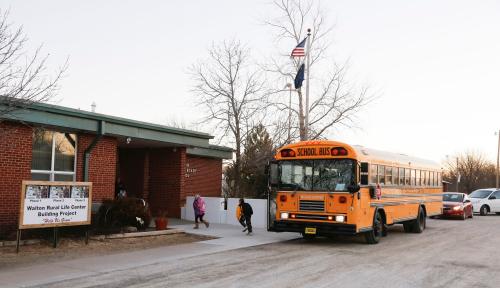Americans are waking up to the plight of rural and small town areas. Rural students and workers need government and philanthropic help to link to jobs, higher education, and career opportunities, whether near their homes or in cities.
But rural residents need to avoid making matters worse for themselves. One troubling development, adopted totally by local initiative, is for rural schools to operate only four days per week (usually Monday through Thursday). This phenomenon is sweeping the Intermountain West, spreading to 88 districts in Colorado, 43 in Idaho, 30 in Oregon, and nearly half of the districts in Montana. Other parts of the country will likely follow suit.
The first few localities to adopt the four-day school week hoped to save money on transportation, heating, janitorial, and clerical costs. The idea was to add roughly 30 to 90 minutes to each day that students are in school, then on the fifth day (usually Friday) to assign projects and encourage parent and community groups to organize study halls and enrichment activities.
However, savings have been elusive because so many costs—most importantly teacher salaries and equipment leases—are fixed. Even on days off, sports teams use buses and drivers for away games. Savings must come from expendables (for example, fuel for buses and heating, food for student lunches, and pay for hourly employees). There are also offsetting cost increases. School buildings must be kept open longer four days each week and on the fifth day for teacher meetings. Students who spend 90 minutes more per day in school need afternoon snacks.
Most localities adopted the four-day week after the original cost-saving argument was debunked. Why? It isn’t because rural children suffer from spending too many days in school. To the contrary, rural students consistently do less well in college on a variety of outcomes (readiness for credit-bearing courses, grades, rate of progress, graduation) than urban students from similar income groups.
Some school leaders hoped it could lead to more intense teacher collaboration and more writing by students and feedback by teachers. However, as our recent study revealed, good intentions can erode, for example, as good resolutions deteriorate and teachers who were part of the original “deal” leave and are replaced.
The idea has proved contagious because adults like it: Teachers have more free time, and stay-at-home parents like the convenience of taking kids to doctors and doing errands on Friday. Many district leaders who have recently adopted the idea say that it gives them an advantage in competing for teachers, who understandably like the idea of the same pay for 20 percent fewer days at work.
But veteran teachers are also concerned that longer days don’t work for the youngest students, and that an absent teacher or student also loses a larger fraction of the school week. Every Monday is like the first day back from vacation. As we discovered, few localities have compensated by assigning and grading fifth-day projects or organizing new learning opportunities. And the shortened school week poses a hardship for two-earner households and low-income families without the time or means to arrange study halls, field trips, and online coursework. In towns with large numbers of newly settled-out migrant workers, most of the newcomers are at loose ends on the fifth day.
Some rural communities we studied have approached the four-day week with caution, intending to go back to five days if results for kids are not good. However, most communities that have adopted it view it as a permanent arrangement, not a trial to be evaluated and reconsidered in light of evidence.
If local leaders are lucky, graduates of these schools won’t be any less well educated than their siblings who went to school all week. But, in an environment where young rural adults already suffer from isolation and low economic opportunity, the shorter school week could exacerbate their problems.
To date, this has been a local phenomenon, based on support from vocal families and signals from the teacher labor market. States have done little to discourage it, and they aren’t requiring thoughtful use of the fifth day nor helping localities offer higher teacher salaries for a longer work week.
Some foundations—for example, the Donnell-Kay Foundation in Colorado and The J.A. and Kathryn Albertson Foundation in Idaho—are exhorting local leaders and offering money to help beef up the lost day. A larger philanthropic effort might make a difference nationwide.
In the meantime, rural mayors and school boards need to be challenged: Will they give in to the four-day week contagion? Will they try it but be alert to signs it isn’t working or needs rethinking? Or will they refuse to take the risk that harm to students might become apparent only when it is too late?
The Brookings Institution is committed to quality, independence, and impact.
We are supported by a diverse array of funders. In line with our values and policies, each Brookings publication represents the sole views of its author(s).








